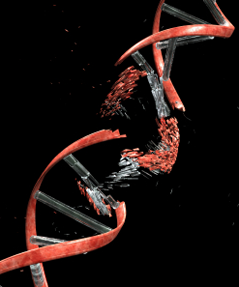New Gene Sharply Increases Breast Cancer Risk
A mutation in the PALB2 gene sharply increases the risk of breast cancer and confers a lifetime risk similar to that of BRCA2 mutation carriers, according to a new study.
PALB2 mutations sharply increase the risk of breast cancer.

A germline loss-of-function mutation in the PALB2 (partner and localizer of BRCA2) gene was previously linked to breast cancer but the lifetime risk of a breast cancer diagnosis for those with the mutation was previously unknown. Now, Marc Tischkowitz, associate professor of medical genetics at the University of Cambridge in the United Kingdom, and colleagues show that patients with mutations in PALB2 have a lifetime risk of breast cancer similar to BRCA2 mutation carriers. The results are published in the New England Journal of Medicine.
Several genetic tests already screen for mutations in the PALB2 gene along with mutations in the BRCA genes.
The researchers analyzed 362 family members of 154 families who were all PALB2 mutation carriers. All individuals had at least one family member who had been diagnosed with breast cancer and was a carrier of a deleterious PALB2 mutation. None of the individuals were BRCA1 or BRCA2 mutation carriers. The individuals came from 14 different research centers-there were no significant differences in the prevalence of the gene by geography.
A total of 48 different types of PALB2 mutations-including truncations, splice mutations, and deletions-were identified.
Compared with the general population, the risk of breast cancer in women with the PALB2 mutation was eight to nine times higher among those younger than 40 years of age, and six to eight times higher for women between the ages of 40 and 60. For women older than age 60, the risk was five times greater compared with non-PALB2 mutation carriers. The estimated cumulative risk of breast cancer among PALB2 mutation carriers was 14% by the age of 50 and 35% by the age of 70 according to the study.
The absolute breast cancer risk by age 70 for women who are PALB2 mutation carriers ranged from 33% for women with no breast cancer family history to 58% for women who have two or more first-degree relatives who were diagnosed with the disease by 50 years of age.
Women with a germline BRCA1 or BRCA2 mutation generally have a 40% to 70% chance of developing breast cancer by the age of 70.
The authors noted that an individual’s risk of breast cancer linked to a PALB2 mutation is also likely to depend on other genes and familial factors which still need to be determined.
The risk of ovarian cancer increased by 2.3-fold among PALB2 carriers, but this result was not statistically significant in the study. Larger studies are needed to assess whether this mutation confers an elevated risk of ovarian cancer.
Among the study participants, there were 311 women with PALB2 mutations. Of these, 229 (74%) had been diagnosed with breast cancer. Of the 51 men with a PALB2 mutation, 7 had breast cancer.
Estrogen receptor (ER) status was available for 129 PALB2 mutation carriers who had breast cancer. Of these, 74% (95 of 129) were ER-positive, similar to the frequency previously seen for BRCA2 mutation carriers and for sporadic breast cancer cases, according to the authors.
Progesterone-receptor and HER2 status was known for a total of 63 of the women with breast cancer. Of these, 30% (19) had triple-negative breast cancer-a frequency higher than the 12% to 17% generally seen among breast cancer patients.
PALB2 was originally identified as a BRCA2-interacting protein and has been shown to also interact with BRCA1.
Still, larger studies are needed to understand how environment, lifestyle, and hormone levels interact with a PALB2 mutation, and if this can influence breast cancer risk. These larger studies may also provide clarity on whether there are any differences in prevalence of the gene based on geography.
“On the basis of our estimates of risk, women with loss-of-function mutations in PALB2 should be studied to determine whether enhanced surveillance for breast cancer, in line with that offered to women with mutations in BRCA2, can influence outcomes,” the authors concluded.